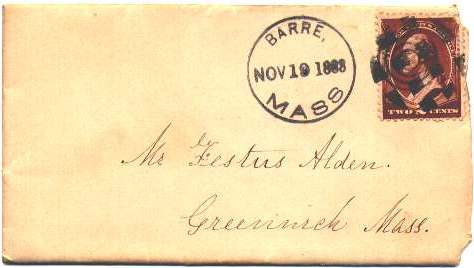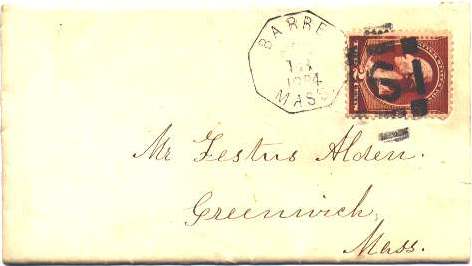
|
The Classic Cancel |
"running man"
Quality 19th Century U.S. Stamps, Cancels and Postal History
|
|
|
|
|
"running man" |
Quality 19th Century U.S. Stamps, Cancels and Postal History |
Analysis of the Barre, Massachusetts Killers, 1880-91 (Page 1)
(Page 2) (Page 3) (Page 4) (Page 5) (Articles Main) (Home)
by John Valenti
In the August 2001 issue of the NEWS, Roger Curran presented a fascinating article detailing the very interesting hand-carved letter killers used by the Barre, MA post office in the mid-to-late 1880s ("The Men of Letters in the Barre Post Office"). This article examined covers principally from the collection of USCC member Arthur Beane. How excited I was, therefore, that within a week of the NEWS arriving in my mailbox, I was able to acquire an extensive correspondence from a Barre family (the Aldens) that contained numerous examples of these killers (44 covers from the period studied). Moreover, the correspondence contained examples of new killers not previously reported. Using information and illustrations from the August article and new data from the Alden covers (all of which contained dated letters), I have developed further information about the sequencing of the killers and their periods of their use.
My approach to studying the killers involves an analysis of the postmark dials used with these cancellations. Table 1 details the Barre postmarks found on the covers during the period analyzed. Table 2 catalogs and organizes the different killers, describing them in detail. Finally, Table 3 cross-tabulates the killers to the postmarks with which they were used and presents the earliest and latest dates of use for both the postmarks and killers.
As noted in the earlier article, the Barre post office during the late 1870s and early 1880s utilized a cancellation device composed of a duplexed postmark and 4 ring target killer (Table 1, dial 1a and 1b). In the period 1878-9, magenta cancellation ink was used. Thereafter, through 1884, strikes of this cancellation device appear only in black ink.
Beginning in late 1883, while the Barre post office still used this duplexed target killer, it began the unusual practice of canceling stamps both with the duplexed target and with an unduplexed hand-carved killer. The cover in Figure 1, dated November 19, 1883, bears both the dial 1b target and a separate circular grid killer (Table 2, killer Grid1). This same killer appears later with a different duplexed target and double ring postmark (Table 1, dial 3) in early 1884.

Figure 1
The cover in Figure 2 shows the next recorded instance of using an unduplexed killer, this time without a duplex target also being present. This February 18, 1884 cover bears both an octagonal postmark (Table 1, dial 4, the only recorded instance) tying the stamp and a strike of an unduplexed letter S in a vertical segmented box (Table 2, killer S1). Another example of this same killer appeared in Figure 2 of the earlier article on a August 15, 1884 cover additionally bearing the dial 1b target (its latest recorded use).
Figure 3 illustrates a return to double cancellation. This November 9, 1885 cover features a duplexed target and postmark similar to the 1b dial, but this dial replaces the year date with a "P.M" time indicator (Table 1, dial 2, only recorded use). The unduplexed Grid2 killer is an unusual grid composed of seven vertical bars, struck in such a way as to cover nearly the entire stamp (just tying at right) and giving the appearance of George Washington in jail. Also notable about this cover is its 1885 use, the only one recorded either from the entire Alden correspondence or from the Beane collection.

Figure 2